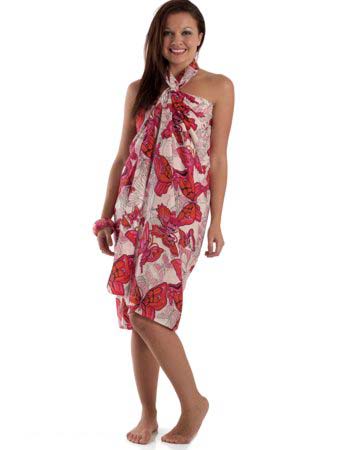
Kebaya is a habitual blouse-dress combination for Indonesian females. The kebaya is also recognized in some Asian countries like Malaysia, Burma, Singapore, Brunei, Thailand and Cambodia. It can be made from sheer material and worn with a sarong or batik kain panjang, or other traditional woven garment such as ikat, songket with a colorful motif.
During the nineteenth century, and prior to the Nationalist movement of the early 20th century, the model of kebaya had enjoyed a period of being worn by Indonesian, Eurasian, and European women alike, with trivial style variations. In this time distinguishing class and category was important and produced variants of the basic set of clothes. Now we may appreciate the modern kebaya ( or in Indonesia called as model kebaya modern) that may be made of silk, velvet and brocade.


There are two main kinds of the Indonesian traditional clothing. The first one is known as baju kebaya and the second one is baju kurung. The baju kebaya may have two highest forms: the semi-transparent straighter cut blouse of the Java or Bali and the more tightly tailored Sunda kebaya. The baju kurung is a loose-fitting, knee-length long-sleeved blouse worn in the additional adherent Muslim areas- including former Kingdom of Johor-Riau (now Malaysia), Sumatra and parts of coastal Java.

The blouse is generally semi-transparent and worn over the torso wrap. The skirt or kain is an unstitched material wrap around three metres long. The name sarong in English is erroneous, but the sarung (Malaysian accent: sarong) is truly stitched together to shape a tube just like a Western costume.

In Indonesia, especially in Java, Bali and Sunda, the kebaya modern is generally batik which can be from natural stamped cotton to elaborately hand - painted batik tulis embroidered silk with gold thread. In several other areas of Indonesia such as Sumatera, Flores, Lemata Timor, and other islands generally use kain ikat or songket. In Sumba, there is a well-known decorated kain with lau hada: shells and beads.

In Bali, the kebaya has more topical history. The Dutch are believed to have enforced the wearing of the Indonesia traditional clothing. At the time Balinese women's breasts were uncovered, excepting for official and ritual occasions, during which a sabuk might be wound tightly around the upper torso, covering the breasts but leaving the shoulders and arms exposed. The girls of Buleleng, the regency of northern Bali, therefore would have been some of the first to adopt the kebaya as their daily clothes.
Article Source:
http://EzineArticles.com/4990256Image Sources:
http://3.bp.blogspot.com/http://srv-live-01.lazada.com.my/http://1.bp.blogspot.com/http://www.bellanaija.com/https://s-media-cache-ak0.pinimg.com/